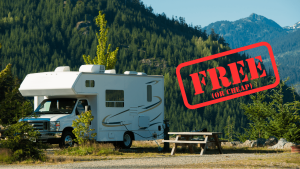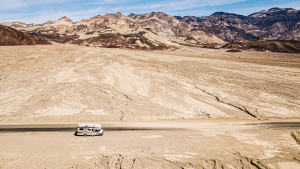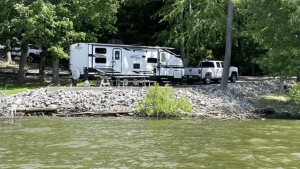For many RVers, camping in a national park is the highlight of a trip. The views, wildlife, and proximity to hiking trails make these campgrounds some of the most sought-after in the country. But before you lock in your plans, there’s one detail that can make or break your stay: the size of your RV.
Most national park campgrounds were built before modern RVs reached today’s sizes. As a result, many sites can’t accommodate longer rigs, and access roads weren’t designed for large vehicles.
Key Highlights
- National parks often limit RV length due to older roads and campground layouts
- RVs over 35 feet have far fewer camping options inside national parks
- Additional restrictions include height, width, and combined vehicle length
- Measure your RV’s exact length, height, width, and combined towing length to avoid access issues at parks and campgrounds
- Use Recreation.gov and official NPS websites to find campground-specific restrictions
How Long Is Too Long?
According to data gathered by RV Share and publicly available campground records:
- About 93% of national park campgrounds accept RVs up to 25 feet
- At 32 feet, the number drops to 81%
- At 40 feet, only 53% of parks can accommodate
- Just 7% of parks accept RVs over 40 feet
These numbers show a clear trend: the longer your RV, the fewer camping options you’ll have inside national parks.
Park and State Differences
Just because a park allows RVs doesn’t mean your rig will fit. Length limits aren’t the same across the board. Some states are more generous, while others stick to tighter restrictions because of narrow roads, old campground layouts, or terrain.
Here’s a look at how it varies:
- Alaska: Most campgrounds here offer more space. Sites that accept RVs up to 40 feet are common, thanks to larger layouts and fewer space limitations.
- Arizona: It’s a mixed bag. Some parks allow up to 50 feet, others closer to 30. Always check individual listings, especially in popular parks like the Grand Canyon or Saguaro.
- California: Expect a wide range. Some parks have newer campgrounds that take 40- to 50-foot rigs. Others, like those along the coast or in the mountains, may max out at 25 to 30 feet.
- Tennessee: You’ll find everything from 12-foot sites in older parks to 40-foot spots in newer campgrounds. It varies a lot depending on the park and how it was built.
- Maine: Many campgrounds top out at around 35 feet. That can be a tight fit for fifth wheels and longer Class A motorhomes.
- South Dakota: Some parks are more relaxed, but not all. Don’t assume every site will fit a big rig just because one or two do.
Always read the site details before booking. A campground might accept RVs up to 40 feet overall, but that doesn’t mean every site in the loop can. You’ll want to check the specific site, not just the campground overview.
Other Size Restrictions That Could Impact Your Trip
Length isn’t the only factor that matters. Even if your RV fits the campground, getting there may still present challenges due to height, width, and road design.
Height: Measure Everything
Most RVs fall between 10 and 12 feet tall. However, rooftop accessories, like air conditioning units, antennas, and solar panels, can push that number higher. This can be an issue as certain tunnels, bridges, and tree-lined roads have vehicle size restrictions.
For example, Zion National Park’s historic tunnel restricts any vehicle that is over 7 feet 10 inches in width and/or 11 feet 4 inches in height. These vehicles are required to have a tunnel permit, which costs $15 at the time of this writing. Some bridges in other parks may have clearances below 12 feet.
Always measure your RV’s total height and keep it written on the dashboard. RV-specific GPS apps can route you around problem areas.
Road and Vehicle Width
Several parks have winding, narrow roads that weren’t built for wide vehicles. Sharp turns, limited shoulders, and tight clearances are common in parks like Sequoia and the Great Smoky Mountains. This is especially important for trailers and fifth wheels.
Also, watch for limits on combined vehicle length, which includes both your RV and any towed vehicles. Some park roads cap total length at 50 feet or less.
How to Know if Your RV or Trailer Fits National Park Limits
National parks are great, but they’re not built for every RV. Some sites are tight, some roads are worse, and if your rig’s too big, you might not get in at all. Here’s how to find out if your setup will actually fit.
Start by Measuring It Yourself
Don’t just go off the spec sheet or what the dealer told you. Get out the tape measure and check it yourself.
- Length: Measure from the very front to the very back. That includes hitches, spare tires, ladders, and bike racks. Anything sticking out counts.
- Height: Measure from the ground to the top of your tallest roof feature. AC units, solar panels, satellite domes. All of it matters.
- Width: Measure across the widest point with your slide-outs closed. Slide-outs don’t matter on the road, but they can make tight campsites even tighter.
- Combined Length: If you’re towing, add the full length of both the RV and the tow vehicle. Some campgrounds and park roads have combined length restrictions.
Write your numbers down and keep them handy. You’ll need them when booking sites or planning routes. Guessing doesn’t work well at a tunnel entrance.
Use Recreation.gov to Check Site Sizes
Recreation.gov is where you’ll book most national park campsites. Each campground page lists size limits, but you’ll get the real info by clicking into individual sites.
Look for:
- Maximum vehicle length
- Driveway surface and dimensions
- Hookup availability
- Generator restrictions
Don’t assume a campground can fit your RV just because it’s listed as RV-friendly. Many only have a handful of longer spots, and they go quickly.
Check the Roads Too
Campgrounds aside, getting to them is sometimes the harder part. Some national park roads were built back when RVs weren’t much more than vans.
Here are a few examples:
- Zion National Park: If your RV is over 11 feet 4 inches tall or 7 feet 10 inches wide (mirror to mirror), you’ll need a tunnel permit and an escort through the Zion–Mt. Carmel Tunnel.
- Sequoia National Park: The Generals Highway has sharp turns and steep drops. Trailers over 22 feet are strongly discouraged.
Head to nps.gov, find the park’s page, and look for the “Plan Your Visit” or “Road Conditions” section. That’s where you’ll find warnings about road size limits and closures.
Use the Right Apps and GPS
Don’t trust your phone’s default GPS when you’re hauling a 35-foot trailer. It’ll take you right to a 10-foot bridge with no warning.
Instead, try:
- RV LIFE App
- CoPilot RV
- Garmin RV GPS units
These let you plug in your rig’s exact size and give you routes that avoid low clearances, weight limits, and restricted roads.
When in Doubt, Just Call
If you’re still unsure or your rig is right on the edge of what the site says it allows, call the park directly. Rangers know the layout, and they’ll tell you straight up if your setup won’t work. It’s much better to hear it on the phone than to be turned away at the gate.







You also have to have a National Park Pass!